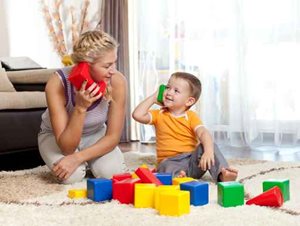Toys That Kick-start the Imagination!
By Lauren Lowry
Hanen Certified SLP and Clinical Staff Writer

 Over the years I've accumulated quite the collection of toys, for use both in my practice as a speech pathologist, and with my own children. While toy trends have come and gone, I've come to realize that there are a few "tried, tested and true" toys that are staples for any toy box, especially when it comes to encouraging pretend play. These toys seem to have three characteristics in common. They:
Over the years I've accumulated quite the collection of toys, for use both in my practice as a speech pathologist, and with my own children. While toy trends have come and gone, I've come to realize that there are a few "tried, tested and true" toys that are staples for any toy box, especially when it comes to encouraging pretend play. These toys seem to have three characteristics in common. They:
- are open-ended – there is more than one way to play with the toy
- promote interaction – they encourage collaboration and conversation
- can be used for simple or elaborate pretending – these toys can stimulate your child's imagination from toddlerhood into the early school-aged years
Before choosing a toy for your child...
The toy suggestions below are only a guide. The best guide is your child and his interests. He may be fascinated by something that is not on the list below, such as dinosaurs. If this is the case, then your toy box might include different items than those listed below. Always follow your child's lead.
Toys that encourage pretend play
For each toy below, there are recommendations for children who are just beginning to pretend ("new pretenders") as well as children who already engage in some pretending ("experienced pretenders"). To determine your child's stage of pretend play development, refer to the guidelines in our article "The Land of Make Believe".
Beware of:
- Bells and whistles. Sometimes too many buttons or electronic parts can mean that the child's focus shifts to button-pressing instead of using his or her imagination
- Close-ended toys. Some toys have a specific end product (like a Lego set that creates a specific vehicle) or only one way to use the toy (like a remote controlled car). These types of toys can encourage certain skills (such as fine motor ability) but they can be restrictive when it comes to using the imagination.
Remember, if you follow your child's lead, it will be obvious what toys you should include in your toy box. For tips on encouraging your child's pretend play skills, read our article "The Land of Make Believe "
The Hanen Centre is a Canadian not-for-profit charitable organization with a global reach. Its mission is to provide parents, caregivers, early childhood educators and speech-language pathologists with the knowledge and training they need to help young children develop the best possible language, social and literacy skills. This includes children who have or are at risk for language delays, those with developmental challenges such as autism, and those who are developing typically.
Click on the links below to learn more about how Hanen can help you help children communicate: